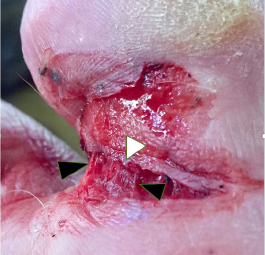The Case
A 45-year-old man is brought to the emergency department with a toe injury. The patient states he was at a cookout drinking alcohol when he developed pain in his great toe and noticed bleeding while walking. He stumbled and thinks he stepped on a broken piece of glass. He denies any other injuries or loss of consciousness. He is intoxicated with a Glasgow Coma Score 14–15 (for slight verbal disorientation at the time), is slightly agitated but redirectable, and has stable vital signs. Examination of his toe shows tenderness to palpation without deformity, and there are no signs of neurovascular compromise. His injury is shown in Figure 1. A radiograph is negative for fracture or foreign body. What do you suspect happened?
Explore This Issue
ACEP Now: Vol 40 – No 07 – July 2021Describing and Classifying Wounds
From a forensic and mechanistic perspective, traumatic injuries can be divided into two categories: blunt trauma and sharp force trauma. Blunt trauma results from an impact with a dull, firm surface or object. Injuries can be patterned (ie, the characteristics of the wound suggest a particular type of blunt object) or nonspecific. Blunt trauma is typically caused by contact with a solid, firm surface (floor or ground) or with an object (such as a fist, bat, or bottle). Sharp force trauma describes an injury produced by an instrument with a thin edge or point (ie, sharp cutting implements).
Blunt trauma injuries include abrasions, bruises/contusions, hematomas, avulsions, fractures, and lacerations. Sharp force injuries include stab wounds, incised wounds, and cuts. Even though lacerations and cuts both involve a break in the skin, they are not synonymous, and the terms should not be used interchangeably. Most emergency physicians and clinicians use the term “laceration” incorrectly to mean any break in the skin, especially one that requires closure, but it really only applies to those skin breaks that are the result of blunt force trauma or contact with an object. Though they may appear similar, especially if they are linear, they are mechanistically different. Here’s why being precise with these terms, and using the strict definitions, can help documentation, especially for forensics purposes.

Figure 1: Wound on right great toe depictinged irregular wound edge (white arrowhead) and tissue bridging (black arrowheads).
Lacerations are sustained via two mechanisms: crushing and tearing. Crush lacerations occur when tissue is compressed between two objects with enough force to cause skin breakage. Lacerations are usually full thickness and are seen when the skin and soft tissue are crushed between the impacting object and underlying bone. Lacerations are often linear but can be irregularly shaped. Blood vessels and nerves can be exposed. The wound edges of a laceration are frequently irregular, bruised, or macerated. Such wounds may be contaminated. Delicate tissue bridges can be seen within the depth of the wound. In fact, tissue bridging is the hallmark finding in lacerations. In cuts, these tissue bridges are disrupted by the sharp edge of the weapon.
Split lacerations occur when tissue is stretched at two points resulting in splitting or tearing at the weakest point in between. This mechanism is classically seen in genital trauma following sexual assault. The wound edges of split lacerations may not exhibit damaged wound edges and may not include tissue bridging.
Sharp force wound edges are characteristically sharp, clean, unbruised, unabraded, and inverted. There is no tissue bridging, and the injuries tend to be more linear. The deeper tissues are cut cleanly in the same plane. Stab wounds are deeper than their length or width and occur when a sharp object is thrust into the skin. Incised wounds and cuts are greater in width and/or length than depth and occur when a sharp implement is dragged over the skin surface.
Pages: 1 2 3 | Single Page



No Responses to “Use Accurate Wound Terminology When Describing Injuries”